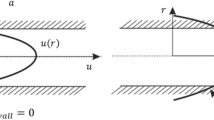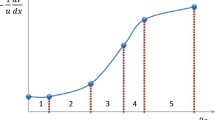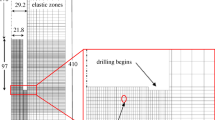Abstract
Abstract. An accurate analytical interpretation method to determine the Leverett function (fw)and its derivative (fw′) from immiscible displacement data in core plugs is presented. Linear equations are developed to describe the displacement processes occurring before and after breakthrough. A quadratic function is introduced to represent the saturation distribution along the cores. The relationships derived in this study can be used for analysis of core tests involving constant injection rates and constant pressure differences. The applicability, practicality, and accuracy of the new analytical method are verified by means of the experimental data obtained in the present study and by those reported in the literature.
Similar content being viewed by others
References
Leverett, M. C.: Capillary behavior in porous solids, Trans. AIME 142 (1941), 152–169.
Buckley, S. E. and Leverett, M. C.: Mechanism of fluid displacement in sands, Trans. AIME 146 (1942), 107–116.
Welge, H. J.: A simplified method for computing oil recovery by gas or water drive, Trans. AIME 195 (1952), 91–98.
Sigmund, P. M. and McCaffery, F. G.: An improved unsteady-state procedure for determining the relative permeability characteristics of heterogeneous porous media, SPEJ, Feb., (1979), 15–28.
Johnson, E. F., Bossler, D. P. and Naumann, V. O.: Calculation of relative permeability from displacement experiments, Trans. AIME 216 (1959), 370–372.
Civan, F. and Donaldson, E. C.: Relative permeability from unsteady-state displacements with capillary pressure included, SPE Formation Evaluation, June, (1989), 189–193.
Tóth J.: A relatív permeabilitás-görbe számítása a kiszorítási folyamat mérési adataiból, Kõolaj és Földgáz 15(115) (1982), 4 102–105.
Odeh, A. S. and Dotson, B. J.: A method for reducing the rate effect on oil and water relative permeabilities calculated from dynamic displacement data, JPT Nov., (1985), 2051–2058.
Islam, M. R. and Bentsen, R. G.: A dynamic method for measuring relative permeability, J. Canad. Pet. Tech., Jan.–Feb., (1986), 39–50.
Batyky, J. P., McCaffery, F. G., Hodgins, P. K. and Fisher, D. B.: Interpreting relative permeability and wettability from unsteady-state displacement measurements, SPEJ June, (1981), 296–308.
Jones, S. C. and Roszelle, W. O.: Graphical techniques for determining relative permeability from displacement experiments, JPT, May, (1978), 807–817
Tóth J.: Determination of the Leverett-and relative permeability functions from waterflood experiments, Kõolaj és Földgáz 28(128) (1995), 3 65–71.
Craig, F. F. jr.: The Reservoir Engineering Aspects of Waterflooding, SPE of AIME, New York, Dallas, 1971.
Shen, C. and Ruth, D. W.: Impact of inlet boundary conditions on the numerical simulation of one-dimensional coreflooding, JCPT 35(1) (1996), 19–24.
Ucan, S., Civan, F. and Evans, R. D.: Uniqueness and simultaneous predictability of relative permeability and capillary pressure by discrete and continuous means, JCPT 36(4) (1997), 52–61.
Author information
Authors and Affiliations
Rights and permissions
About this article
Cite this article
Toth, J., Bodi, T., Szucs, P. et al. Practical Method for Analysis of Immiscible Displacement in Laboratory Core Tests. Transport in Porous Media 31, 347–363 (1998). https://doi.org/10.1023/A:1006570117639
Issue Date:
DOI: https://doi.org/10.1023/A:1006570117639




